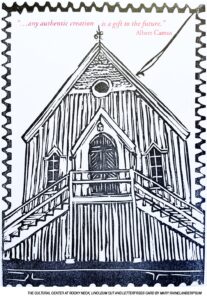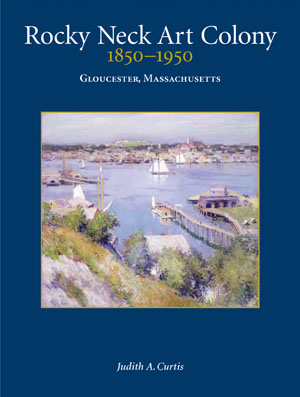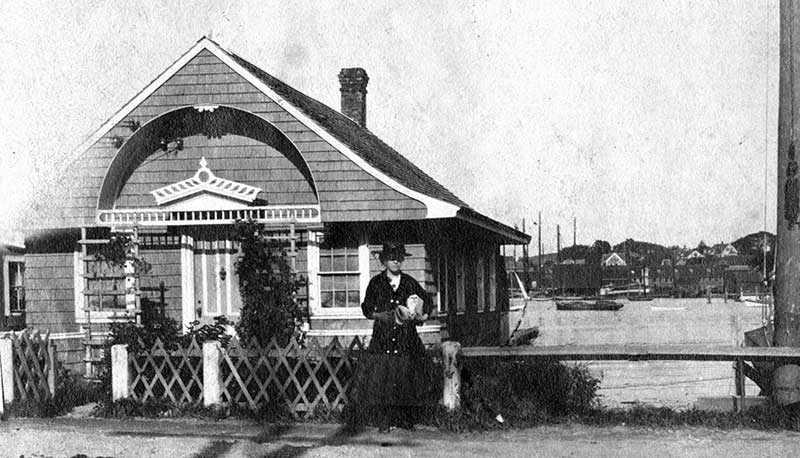The History of Rocky Neck
The Rocky Neck Art Colony is one of the oldest working art colonies in the country, and has been luring artists to its picturesque shores for more than 150 years.
Among others, these artists include Fitz Henry Lane in the 1840s, Emile Gruppe, who made The Neck his home and painted into the 1970s, as well as Childe Hassam, Milton Avery, Maurice Prendergast, Cecilia Beaux, John Sloan, Stuart Davis, Frank Duveneck, Nell Blaine, and Jane Peterson.
Today the area is still home to many working artists and to galleries showing paintings, batik, photography, jewelry, prints, sculpture, ceramics, and fine gifts.
In addition to viewing the arts, one may snack or dine at unique restaurants that feature fine food and fabulous views.
 A Little History of 6 Wonson Street
A Little History of 6 Wonson Street
The historic carpenter-gothic building was constructed in 1877 as a meeting house for the neighborhood. It was originally home to religious services, political meetings, neighborhood events and some theater.
Over the years, the property changed hands, served as an art gallery, and in the 1950s was purchased and operated by The Church of Christ, Scientist until 2011.
In 2012, the property was purchased and held for the Rocky Neck Art Colony, Inc., by members Steve and Kathy Archer. That year RNAC began a capital campaign to purchase the building, and completed the campaign goal in 2014.
RNAC purchased the building from the Archers at market value, paying off the mortgage completely in May 2014. The capital campaign’s success was due to a large and generous group of local donors and grant funding. Today the Cultural Center at Rocky Neck is home to exhibitions, art workshops, lectures, music — all things cultural!
Visit the Rocky Neck Historic Art Trail
The Rocky Neck Historic Art Trail takes you to fifteen sites of art historical significance in one of America’s most visually arresting locales. Rocky Neck is a granite promontory with tide flats and wharf buildings separating the harbor proper from Smith’s Cove in Gloucester, Massachusetts. With its scenic views and humble waterfront buildings, this spit of land measuring less than one square mile has since the early 19th century beckoned a steady stream of painters, sculptors and writers to its picturesque shores. Regarded by many to be “America’s Oldest Working Art Colony,” the artists’ enclave at Rocky Neck during the period from 1850 to 1950 attracted a number of the most important realist painters in the annals of American art.
By mapping the sites where they worked, lived and became inspired, the Rocky Neck Historic Art Trail enables you to walk in the footsteps of Winslow Homer, Fitz Henry Lane, Augustus Buhler, Frank Duveneck, Marsden Hartley, Edward Hopper and a host of other pioneering American artists, and to see first-hand the iconic land and seascapes that gave rise to their illustrious artistic output. It is hoped that, by enabling you to identify where historical artistic events took place and to see them in the context of what remains today, the Trail documents will ensure you make the most of your visit to one of the special places in the history of American art.
Rocky Neck Art Colony 1850–1950
Written by Judith A. Curtis, designed by Stephen Bridges

This book offers an in-depth look at America’s oldest working art colony with over 130 fine art reproductions from the artists who painted there. Click photo (above) to purchase. Retail cost $34.95
Cradle of painters, poets and visionaries, Gloucester, Massachusetts, has played a vital role in the nation’s art history since the mid-1800s.
For more than a century, beginning with marine artist Fitz Henry Lane, this bustling seaport—the oldest working harbor in the nation—has inspired myriad creative souls. The harbor, coupled with Cape Ann’s unique luminescent glow and rugged topography, offered everything the plein air painter could possibly want.
In addition, the dichotomy between the hardy fishermen and the genteel summer visitors of East Gloucester resulted in the artists banding together to form their own sense of community. So was born the Rocky Neck Art Colony.
Over the years—beginning with Lane’s Gloucester Harbor from Rocky Neck in 1844, through Winslow Homer’s first visit in 1873, the arrival of Frank Duveneck and his friends and followers, and the presence of the New York contingent headed by John Sloan and Stuart Davis—Gloucester’s Rocky Neck evolved into a microcosm of American art that has never been surpassed.
Judith A. Curtis is a freelance writer specializing in art-related themes. Ms. Curtis lives on Cape Ann, and is a regular contributor to the American Art Review. She has also written several books, including Anthony Thieme, The Life and Art of Paul Strisik, N. A., W. Lester Stevens, N. A., (1888-1969), and Harry A. Vincent and His Contemporaries.
Title is also available for resale. Please call 978-515-7004 for wholesale information.

